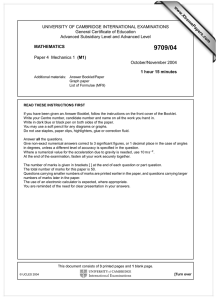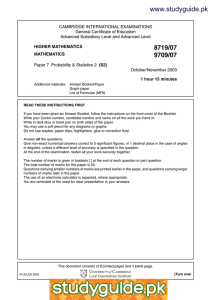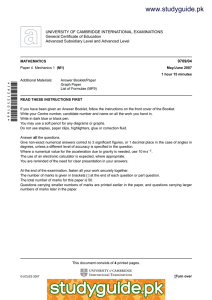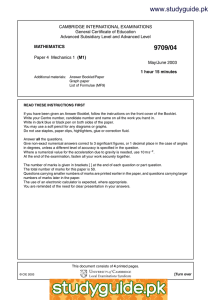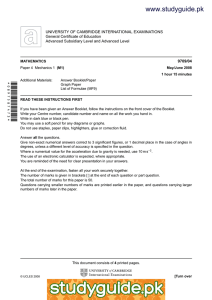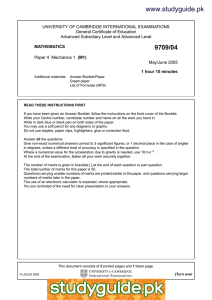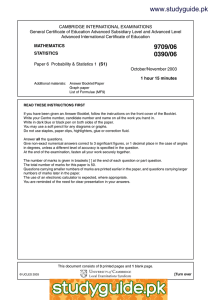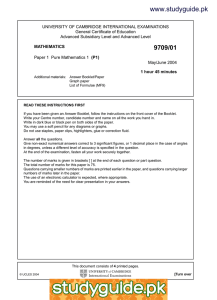www.studyguide.pk
advertisement
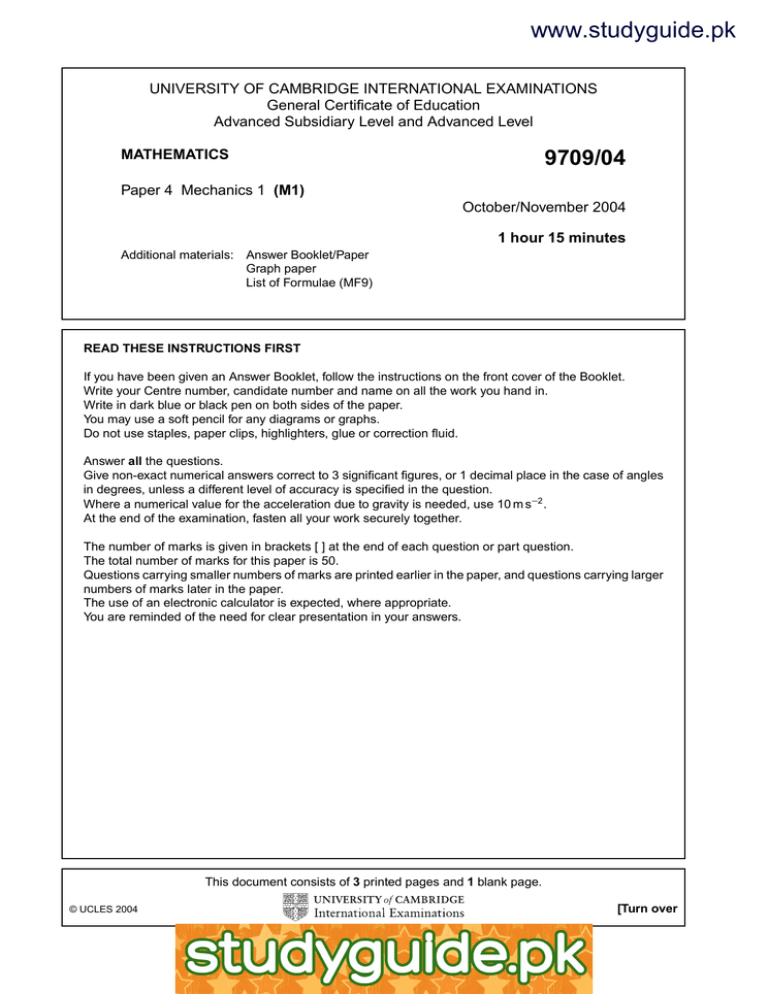
www.studyguide.pk UNIVERSITY OF CAMBRIDGE INTERNATIONAL EXAMINATIONS General Certificate of Education Advanced Subsidiary Level and Advanced Level MATHEMATICS 9709/04 Paper 4 Mechanics 1 (M1) October/November 2004 1 hour 15 minutes Additional materials: Answer Booklet/Paper Graph paper List of Formulae (MF9) READ THESE INSTRUCTIONS FIRST If you have been given an Answer Booklet, follow the instructions on the front cover of the Booklet. Write your Centre number, candidate number and name on all the work you hand in. Write in dark blue or black pen on both sides of the paper. You may use a soft pencil for any diagrams or graphs. Do not use staples, paper clips, highlighters, glue or correction fluid. Answer all the questions. Give non-exact numerical answers correct to 3 significant figures, or 1 decimal place in the case of angles in degrees, unless a different level of accuracy is specified in the question. Where a numerical value for the acceleration due to gravity is needed, use 10 m s−2 . At the end of the examination, fasten all your work securely together. The number of marks is given in brackets [ ] at the end of each question or part question. The total number of marks for this paper is 50. Questions carrying smaller numbers of marks are printed earlier in the paper, and questions carrying larger numbers of marks later in the paper. The use of an electronic calculator is expected, where appropriate. You are reminded of the need for clear presentation in your answers. This document consists of 3 printed pages and 1 blank page. [Turn over © UCLES 2004 www.xtremepapers.net www.studyguide.pk 2 1 Two particles P and Q, of masses 1.7 kg and 0.3 kg respectively, are connected by a light inextensible string. P is held on a smooth horizontal table with the string taut and passing over a small smooth pulley fixed at the edge of the table. Q is at rest vertically below the pulley. P is released. Find the acceleration of the particles and the tension in the string. [5] 2 A small block of weight 18 N is held at rest on a smooth plane inclined at 30◦ to the horizontal, by a force of magnitude P N. Find (i) the value of P when the force is parallel to the plane, as in Fig. 1, [2] (ii) the value of P when the force is horizontal, as in Fig. 2. [3] 3 A car of mass 1250 kg travels down a straight hill with the engine working at a power of 22 kW. The hill is inclined at 3◦ to the horizontal and the resistance to motion of the car is 1130 N. Find the speed of the car at an instant when its acceleration is 0.2 m s−2 . [5] 4 A lorry of mass 16 000 kg climbs from the bottom to the top of a straight hill of length 1000 m at a constant speed of 10 m s−1 . The top of the hill is 20 m above the level of the bottom of the hill. The driving force of the lorry is constant and equal to 5000 N. Find (i) the gain in gravitational potential energy of the lorry, [1] (ii) the work done by the driving force, [1] (iii) the work done against the force resisting the motion of the lorry. [1] On reaching the top of the hill the lorry continues along a straight horizontal road against a constant resistance of 1500 N. The driving force of the lorry is not now constant, and the speed of the lorry increases from 10 m s−1 at the top of the hill to 25 m s−1 at the point P. The distance of P from the top of the hill is 2000 m. (iv) Find the work done by the driving force of the lorry while the lorry travels from the top of the [5] hill to P. 9709/04/O/N/04 www.xtremepapers.net www.studyguide.pk 3 5 Particles P and Q start from points A and B respectively, at the same instant, and move towards each other in a horizontal straight line. The initial speeds of P and Q are 5 m s−1 and 3 m s−1 respectively. The accelerations of P and Q are constant and equal to 4 m s−2 and 2 m s−2 respectively (see diagram). (i) Find the speed of P at the instant when the speed of P is 1.8 times the speed of Q. [4] (ii) Given that AB = 51 m, find the time taken from the start until P and Q meet. [4] 6 Two identical boxes, each of mass 400 kg, are at rest, with one on top of the other, on horizontal ground. A horizontal force of magnitude P newtons is applied to the lower box (see diagram). The coefficient of friction between the lower box and the ground is 0.75 and the coefficient of friction between the two boxes is 0.4. (i) Show that the boxes will remain at rest if P ≤ 6000. [2] The boxes start to move with acceleration a m s−2 . (ii) Given that no sliding takes place between the boxes, show that a ≤ 4 and deduce the maximum [7] possible value of P. 7 A particle starts from rest at the point A and travels in a straight line until it reaches the point B. The velocity of the particle t seconds after leaving A is v m s−1 , where v = 0.009t2 − 0.0001t3 . Given that the velocity of the particle when it reaches B is zero, find (i) the time taken for the particle to travel from A to B, [2] (ii) the distance AB, [4] (iii) the maximum velocity of the particle. [4] 9709/04/O/N/04 www.xtremepapers.net www.studyguide.pk 4 BLANK PAGE 9709/04/O/N/04 www.xtremepapers.net
